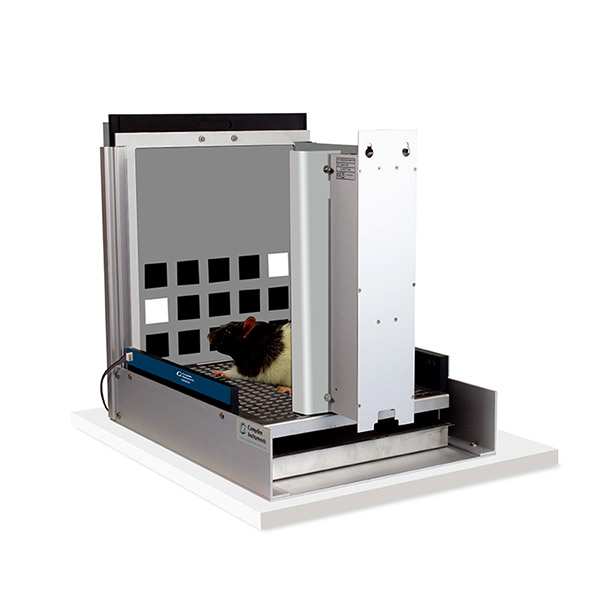
TUNL can be thought of as a version of delayed nonmatching-to-place (DNMTP), in which the subjects are presented with a sample location, and following a delay, with the (incorrect, S-) sample location and a (correct, S+) nonmatching location. DNMTP has been shown to be vulnerable to non-spatial mediating strategies. TUNL eliminates these problems by using multiple, trial-unique locations, preventing the use of mediating strategies. Animals with lesions in the dorsal hippocampus or decreased hippocampal neurogenesis were impaired when the locations were close together, but not when they were far apart. This feature also renders the task exquisitely sensitive to hippocampal dysfunction, tapping both the role of the hippocampus in memory and in pattern separation. The rat version uses 15 individual locations. A simpler version using 5 positions is available for mice.
Rat performing the TUNL task with the 15 window mask.
Tethered mouse performing the TUNL task with the 5 window mask, using the open reward trough 80614A-07-10.
Barnard, I. L., Onofrychuk, T. J., McElroy, D. L., & Howland, J. G. (2021). The Touchscreen‐Based Trial‐Unique, Nonmatching‐To‐Location (TUNL) Task as a Measure of Working Memory and Pattern Separation in Rats and Mice. Current Protocols, 1(9). - Abstract
Palmer, D., Dumont, J. R., Dexter, T. D., Prado, M. A. M., Finger, E., Bussey, T. J., & Saksida, L. M. (2021). Touchscreen cognitive testing: Cross-species translation and co-clinical trials in neurodegenerative and neuropsychiatric disease. In Neurobiology of Learning and Memory (Vol. 182, p. 107443). - Abstract
Shepherd, A., Zhang, T., Hoffmann, L. B., Zeleznikow-Johnston, A. M., Churilov, L., Hannan, A. J., & Burrows, E. L. (2021). A Preclinical Model of Computerized Cognitive Training: Touchscreen Cognitive Testing Enhances Cognition and Hippocampal Cellular Plasticity in Wildtype and Alzheimer's Disease Mice. Frontiers in Behavioral Neuroscience, 15(December), 1-15. - Abstract
Lee, J., van den Buuse, M., Nithianantharajah, J., & Jones, N. C. (2020). Acute NMDA receptor antagonism impairs working memory performance but not attention in rats-Implications for the NMDAr hypofunction theory of schizophrenia. Behavioral Neuroscience, 134(4), 323-331. - Abstract
Mosser, C.-A., Haqqee, Z., Nieto-Posadas, A., Murai, K., Stefano, S., Williams, S., & Brandon, M. P. (2020). The McGill-Mouse-Marmoset Platform: A Standardized Approach for High-throughput Imaging of Neuronal Dynamics During Behavior. BioRxiv. - Abstract
The Second Generation Bussey Chambers with Intelli-interface supports up to 20 chambers on one PC. On the strength of 10 years of feedback and development, the system is even more flexible and with more features.
Adapted for mice, this is a working memory task. TUNL is a delayed nonmatching-to-place task that prevents the mediating strategies associated with the equivalent lever task.

